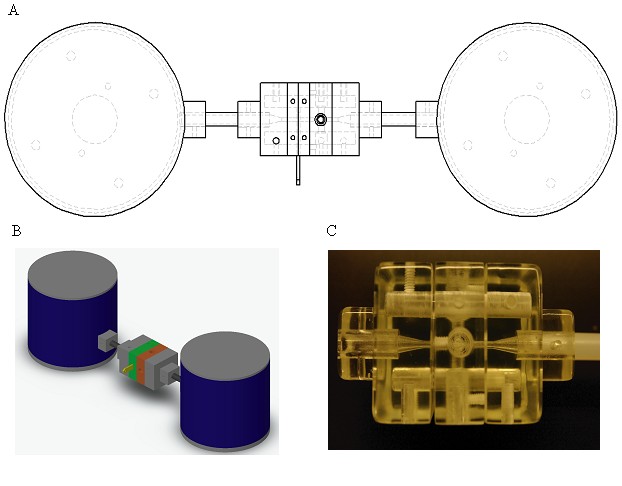|
FlyWorld: an Experimental Biosphere to Study the Genetics, Neural Circuits that Underline Drosophila Behavior
Observation rather than experimentation dominates the study of animal behavior, limiting our understanding. We require the ability to study behavior in which aspects of the environment can be controlled. To meet this goal, we built a multi-chambered, fly biosphere in which we can control parameters to replicate and examine pertinent aspects of a fly’s natural environment, while precisely quantifying a fly’s behavior (See Figure 1.).
The purpose of this research is to develop new methods that will make it possible to efficiently screen complex behavioral phenotypes in the fruit fly, Drosophila melanogaster. The behaviors of interest are those related to higher-order processing related to ‘choice’ (e.g. food and habitat selection, social interactions, migration control), which are difficult to screen and quantify by conventional methods. Although the study of behavior in Drosophila in not new, technological innovations in recent years make possible the design and construction of sophisticated devices, capable of resolving fine phenotypic differences while maintaining high throughput. The basic strategy is to develop an electronic ‘fly world’ – a modular system of software and hardware capable of reliably tracking and controlling the motion of flies within controlled sensory environments. The goal is to develop a flexible instrumentation kit that could be configured like LEGO by individual researchers into a variety of configurations for different behavioral assays. The result will not be a cumbersome custom instrument, but rather a turn-key system that can be used by students and post-docs whose training is in biology, and who may have little or no knowledge of the engineering that underlies the new technology. Put simply, we want make it as easy to develop rigorous new behavioral screens as it is to run a gel or amplify a sequence of DNA.
The opportunity to develop this technology arises because of a synergy among several research groups at Caltech. Seymour Benzer’s laboratory, in the Division of Biology, pioneered the use of Drosophila as a model system for studying the genetic basis of behavior. Our laboratory, housed in the Division of Engineering and Applied Science, specializes in developing electronic and mechanical instrumentation for studying behavior and physiology in flies. Working together, the labs will develop a new set of hardware tools to address several problems related to the genetic basis of complex behavioral traits. This experience will ultimately be used to offer a robust instrumentation kit to the Drosophila community at large.
 Figure 1: Prototype components of FlyWorld system. (A) Top schematic view of simple configuration consisting of two canisters, tubing, detector, and gate. (B) CAD-rendered view of configuration drawn in A. (C) Photograph of prototype detector block fabrication from stereo lithography.
Figure 1: Prototype components of FlyWorld system. (A) Top schematic view of simple configuration consisting of two canisters, tubing, detector, and gate. (B) CAD-rendered view of configuration drawn in A. (C) Photograph of prototype detector block fabrication from stereo lithography.
return to research index
|